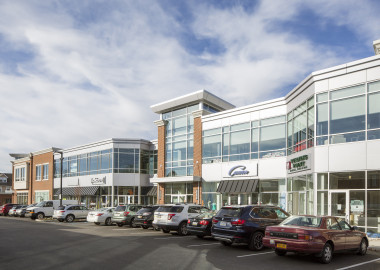Mid-Atlantic Real Estate Journal: 2018 Annual Forecast, “How to Build a Shopper’s Paradise”

Despite concerns about the “death of retail,” the number of retail stores has increased by 180% over the last 40 years while our country’s population has only increased by 40%. Well-located, amenity-rich retail centers are doing better than ever. While demand for traditional, big box retail space may slow in the coming years, an appreciation for the recent and up-and-coming trends in the retail real estate market can help developers and owners get ahead of the competition to reposition existing shopping centers and build exciting new retail developments.
The last few years have seen greater differentiation in storefront design, with façade colors, signage, and awning colors that help to reinforce the national identity of high-profile tenants. We have also seen more accommodations to keep up with tenants’ evolving business models, for example, in adapting existing buildings to add drive-through windows and customized signage designs.
As more retail developers attempt to compete with so-called “destination” or “lifestyle” centers, architects have been endeavoring to create more fun shopping experiences – even in traditional strip-mall settings. Restaurant tenants are demanding outdoor dining space or storefronts that open to simulate the outdoor dining experience. Other features such as attractive hardscaping and varied façade designs have helped to emulate and enhance the streetscape experience.
As we move into 2018, these trends will surely continue, but we can also expect to see groundbreaking new ideas permeate the retail market.
Elevating the customer experience – Ferris wheels, carousels, and sculpture gardens may sound extravagant, but future retail centers will need to incorporate entertainment-focused architectural features that delight and engage consumers. Outdoor public spaces with sculptures and fountains are essential, as are public transportation stops and providing a variety of dining options. Centralizing restaurants and eateries will create next-generation food courts, and we can expect to see more dining venues within retail establishments and pop-up cafes.
Convenience and technology – Convenience is the premium target, and technology such as drone landing zones, Amazon lockers, and Uber and Lyft parking spots may appear within cutting edge developments to meet the challenge. Continually improving customer data can help retailers make personalized recommendations for shoppers, such as in “smart” dressing rooms, which employ technology to suggest complementary items or to help find alternate sizes. Additionally, as technology becomes more integrated into our daily lives, we’ll see more connections between digital and brick-and-mortar shopping experiences.
Making better use of space – In the future, we can expect to see retailers collaborate and share space more effectively, whether on a smaller scale, such as Topshop or J. Crew pop-up shops, or on a larger scale, with multiple retailers sharing the same warehousing and loading space. Marketplaces with a variety of small online or local retailers may make an appearance in traditional shopping centers. Also, with the boundaries between work, home, and play blurring, future retail design will more purposefully incorporate residential, transportation, workplace, and healthcare spaces.
With the retailing landscape changing so rapidly, retail designers need to be proactive in incorporating creative features that will lure tenants and consumers. In 2018, the savvy retailer that supplies a more customized, meaningful, and convenient retail experience is sure to thrive.
John D. Meadows is a registered architect with over 20 years of experience in commercial and retail design. He is a project manager at Bernardon, a regional architecture, interior design, and landscape architecture firm.
Originally published in the Mid-Atlantic Real Estate Journal’s 2018 Annual Forecast
< Return to Noteworthy